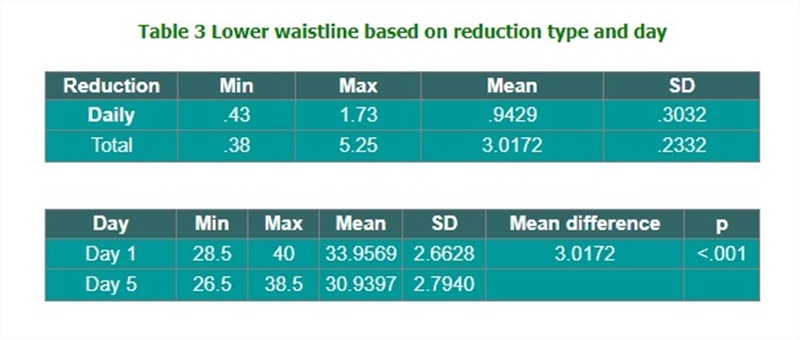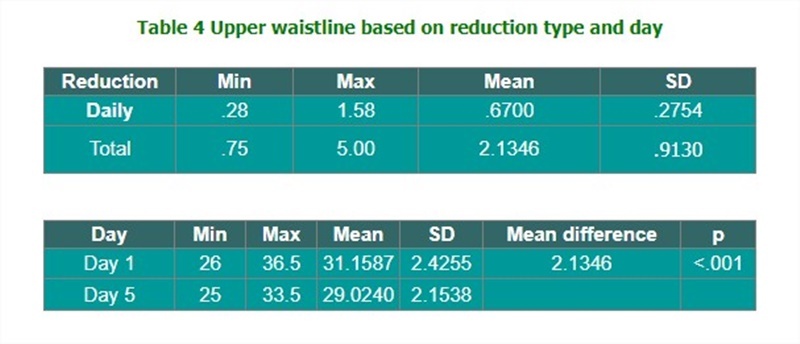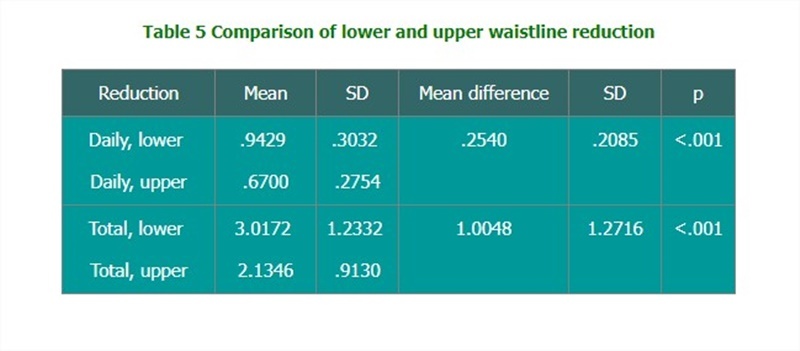Weight and Waistline Reduction of Women after Massage with Cream Containing Medicinal Plant Extract
ABSTRACT
Excessive fat deposit in adipose tissue could impair health. Several methods are recommended to manage this health problem, but they are not entirely effective. An alternative or complementary method may be necessary. Therefore this study is aimed at investigating whether massaging with herbal cream can reduce fat deposits. This one-group experimental study was conducted in Chiang Mai , Thailand , in 2004. The intervention was the once-a-day massage for five consecutive days with cream containing medicinal plant extract. The measures investigated were the weights (kilograms) and waistlines (inches) of woman subjects ( n=29) before and after the intervention. The results showed that massaging with herbal cream can reduce the weight from 58.96 to 58.43 (p<.001), and the waistline from 33.96 to 30.94 (p<.001). This investigation suggested that massaging with herbal cream can reduce weight and waistline of women fat, and be used as an alternative or complementary practice to reduce fat deposits in abdominal adipose tissue.
Key words : weight reduction, waistline reduction, massage, herbal cream, women
INTRODUCTION
Excessive fat deposits in adipose tissue could impair health (Caterson and Gill, 2002). Several methods are recommended to manage this deposit, such as exercise, diet and the use of medicine. However, these methods are not entirely effective. An alternative, or complementary practice, may be required to solve this health problem. People have employed massage therapy as a conventional medicine for health care for a long time. Currently, it is still used to manage health-related problems not only in developing countries, but also in developed ones. People in the United States use several complementary and alternative medicines, including the practice of massage therapy, for health purposes (Barnes et al, 2004; Honda and Jacobson, 2005). Massage therapy has continued to increase in use due to several studies showing the benefits of this practice. The course of massage by a mother and a professional could result in weight gain in preterm infants (Ferbal et al, 2002). Similarly, massage by the mother could improve the growth of newborn infants, i.e., weight, length and head circumference (Field et al, 2004). Furthermore, foot and hand massage could reduce postoperative pain (Wang and Keck, 2004). The practice of massage therapy could also relieve the symptoms of carpal tunnel syndrome (Field et al, 2004) and Parkinson’s symptoms (Reif et al, 2002). Constipation is also a health problem that uses massage therapy to reduce symptoms (Preece, 2002). In addition, massage therapy could improve the symptoms of cancer patients (Cassileth and Vickers, 2004). Besides the evidence supporting the effectiveness to improve health problems, massage therapy is non-invasive, inexpensive, easily practical and quite safe. Injury from massage was reported in a very low number of cases (Grant, 2003). Moreover, there is a tendency to incorporate massage therapy into a research competency (Hymel, 2003 : Hymel, 2005). These previous reports indicate the development of massage therapy in health care. Since the practice of massage therapy is employed for various health purposes, it can be employed to reduce excessive fat deposits, which is also a health problem.
Therefore, this study is concerned with this practice as an alternative method to reduce fat deposits. Additionally, Thai people also employ massage as a traditional therapeutic method for health problems.
Thai people use capsicum and ginger as food, and as herbal medicine for gastrointestinal regulation (Maneekul and Sumranjit, 1998). However, there are studies concerning other therapeutic effects of these herbs. Topical use of capsicum plaster can relieve non-specific low back pain (Frerick et al, 2003). It was also found that ginger extract could be used as a lipid-lowering agent (Thompson et al, 2002). Besides these two herbs, Ginkgo biloba is a well-known medicinal plant orally used for various health benefits in Asia, America and Europe . Many studies have examined its therapeutic efficacy. An investigation has shown that its extract can lower lipid levels (Yao et al, 2004). Based on previous findings, this study expected that massaging with cream could decrease fat deposits. As a result, the objective of the study was to determine the effect of massaging with cream containing a special formulation of these herbal extracts on the weight and waistlines of female subjects. The hypotheses were H 1: massaging with this herbal cream could reduce the weight of female subjects; and H 2: massaging with this herbal cream could reduce the waistlines of female subjects.
METHOD AND MATERIAL
Study design
This one-group experimental study was conducted in Chiang Mai, Thailand, in 2004. The intervention was a five-consecutive-day massage with herbal cream to reduce the weight and waistlines of female subjects. The measures of weight and waistlines before and after the intervention were compared to determine the effect and extent of the intervention. The paired t-test analysis was used to analyze the data at the significance level of 0.05.
Participant recruitment
Female participants were recruited from an announcement of the program persuading women who wanted to reduce their weight and waistlines by massage therapy with herbal cream. The program requested that participants should have enough time to engage in the five-consecutive-day study without payment. The expected benefit participants would obtain was the reduction in their weight and waistlines. Women accepting this request contacted the staff in order to make the appointments of participation. An interview for screening the applicants was conducted to include only those women eligible for the study. The criteria used to select the participants were: having no pregnancy; no use of anti-obesity substance or course before or during the program; and no serious disease. Atfer interviewing, the staff informed the participants about the objective and procedure of the program. When participants knew and understood all information clearly, they filled out the necessary information about their physical data, health status and eating habits on the application form and gave their signature for consent. Initially, there were 30 participants selected, but a participant dropped out after one day because of having no time. As a result, there were 29 participants analyzed in this study.
Measures
Each subject was measured for her weight (kilogram, kg) and height (centimeter, cm). Body Mass Index (BMI), defined as weight in kilograms divided by the square of height in meters, was calculated for each subject. The waistline (in inches) was measured by a standard measure belt before and after every massage. Waistlines were determined at two points. The first was measured along the circumference passing the navel, and referred to as “lower waistline”. The second was measured along the circle above the navel two inches, namely, “upper waistline”. The outcome measures were weight reduction (difference in weight on day 1 and day 5), daily reduction in the waistline (average difference in the waistline on day 1 through day 5) and a total reduction in the waistline (the difference in the waistline on day 1 and day 5).
Material
The cream for the massage contained these main ingredients: the extract from capsicum, ginger, Ginkgo biloba, Super Hi-sol containing hydroxycitric acid, glyceryl monostearate, PEG-4-ceteth-20, benzoate esters, tocopheryl acetate, propylene glycol and menthol.
Massage procedure
Each subject was given one massage with cream (100 gm) each day during the program by a well-trained massagist. Before starting, the subjects had to prepare their clothes for a comfortable massage. In a clean room, they laid down on the bed in a relax manner and put their hands over the heads in order not to interfere with the massagist during massage. The massagist applied each portion of the cream and gently rubbed it with two hands on the waist area. She massaged the cream in a circular direction around the waist area and along the waist circle alternatively until the cream was used up. Each massage took about fifty minutes. Then, she cleaned and dried the waist with some water and a small towel. Subjects laid down for a while (5-10 minutes) before getting up.
RESULTS
Physical data of subjects
Physical data of subjects included age, weight, height and BMI (Table 1). The means were about 38 years, 58 kg, 155 cm and 24 kg/m 2 respectively.

Weight reduction
After the massage, the mean weight of subjects was significantly reduced by about half of a kilogram, from 58.96 to 58.43 kg (Table 2). This result supported Hypothesis 1 that massage used with herbal cream could reduce the weights of the female subjects

Lower waistline reduction
Massaging with herbal cream can also reduce the lower waistlines of almost all subjects each day. There was only a subject where her lower waistline on day 4 did not change. The daily reduction varied from 0.43 to 1.73 inches with a mean of 0.94 inches, while the total reduction ranged from 0.38 to 5.25 inches with the mean of 3.01 inches (Table 3). On day 1, the lower waistlines varied from 28.5 to 40 inches with the mean of 33.96, while on day 5, the lower waistlines ranged from 26.5 to 38.7 inches with the mean of 30.9397 inches. The mean difference of 3.01 inches is significantly different (Table 3). This result indicated that the intervention could reduce the lower waistline of subjects approximately 3 inches. As a result, this finding supported Hypothesis 2 whereby massaging with herbal cream could reduce the waistlines of female subjects.

Upper waistline reduction
Massaging with herbal cream can decrease the upper waistlines of almost all subjects each day. The daily reduction of all subjects varied from 0.28 to 1.58 inches with a mean of 0.67 inches. The total reduction of each subject ranged from 0.75 to 5.00 inches with a mean of 2.13 inches (Table 4). On day 1, the upper waistlines ranged from 26 to 36.5 inches with a mean of 31.16. On day 5, the upper waistlines ranged from 25 to 33.5 inches with a mean of 29.02 inches. The mean difference of 2.13 inches is significantly different (Table 4). This result supported Hypothesis 2 whereby massaging with herbal cream could reduce the waistlines of female subjects.

Comparison of lower and upper waistline reduction
In addition to the findings that massaging with herbal cream can reduce both the upper and lower waistlines, this study also compared the degree of reduction between each waistline. It was found that the reduction of lower waistline was significantly greater than that of the upper waistline (Table 5).

DISCUSSION
The results showed that the five-consecutive-day massage with cream containing medicinal plant extract could significantly reduce the weight and waistlines of woman subjects. This preliminary finding indicated the possibility to use massage with herbal cream as an alternative or complementary practice to reduce fat deposits, especially in abdominal adipose tissue. It was reported that the abdominal adipose tissue, the main site of thermogenic brown adipose tissue, had a high lipolytic activity (Dewailly et al, 1998; McCarty, 2001). Since the cream contained spicy medicinal plants, i.e., capsicum and ginger, it could give a spicy effect. Therefore, it could be explained that the reduction of weight and waistlines could be due to the spicy effect of the herbal cream resulting in fat lipolysis. This effect could result in triglyceride lipolysis in abdominal adipose tissue. However, further studies are necessary to provide more information to confirm the use of massage combined with herbal, cream and its action.
World Health Organization uses BMI, the most useful indicator of total adiposity, to define obesity. People having BMI of 18.5-24.9, >25, and >30 are classified as normal, overweight and obese, respectively (WHO, 2000). According to this classification, some subjects were overweight (n=12) and one subject was obese. From interviewing, these subjects wanted to reduce their weight and waistlines because they felt uncomfortable when moving and knew the plausible danger of being overweight or obese. Though the majority of subjects were normal (n=16), they said that they tended to easily gain weight. A noticeable sign of this tendency was a larger waistline. All subjects had similar thoughts that the more weight gained and the larger the waistline made them less slim, less active, less fit and especially less beautiful. These reasons led them to participate in this investigation and they also expected to reduce their weight and waistlines.
There are several methods to determine the body’s adiposity, such as computerized tomography, magnetic resonance imaging and X-ray absorptiometry (Caterson and Gill, 2002). But this study used the measure of weight and waistlines because it is the easiest method to determine the abdominal adiposity. As well, waistline is the most common indicator for measuring abdominal adipose tissue (Dewailly et al, 1998). In addition, some previous investigations employed the measurements of weight and waist circumference as indicators of adiposity (Savage et al, 2003; Valsamakis et al, 2004).
Limitations
The study could not select only overweight or obese subjects due to time constraints of the five-consecutive-day participation with no payment. The two-group design seemed to be more appropriate, but this study was necessary to employ one-group design because there was no beneficial expectation (reduction in weight and waistline) or incentive (money payment) for a control group.
Suggestions
Since this study investigated the effect of massaging with herbal cream on abdominal adipose tissue, the next study should examine other regions, such as thigh adipose tissue, in order to compare the effects of it. A longer period should also be conducted to see the massage effect in a longer duration.
CONCLUSION
Massage therapy has continued to develop in professional use for several health problems, including excessive fat deposits. Massage with cream containing medicinal plant extract can reduce the weight and waistlines of women. This practice of massage could be used as an alternative or complementary method in managing excessive fat deposits, especially in abdominal adipose tissue.
ACKNOWLEDGEMENT
The authors were grateful to Dr. Pichaet Wiriyachitra for his support and for the cream used in this study.
REFERENCES
- Barnes, P.M., E. Powell-Griner, K. McFann, R.L. Nahin. 2004. Complementary and alternative medicine use among adults: United States, 2002. Seminars in Integrative Medicine, 2: 54-71.
- Cassileth, B.R., A.J. Vickers. 2004. Massage therapy for symptom control: outcome study at a major cancer center. Journal of Pain and Symptom Management, 28(3): 244-249.
- Caterson, I.D., T.P. Gill. 2002. Obesity: epidemiology and possible prevention. Best Practice and Research Clinical Endocrinology and Metabolism, 16(4): 595-610.
- Dewailly, D., C. Cortet-Rudelli, Deroubaix-Allard. 1998. Markers of abdominal adipose tissue in women: relationship to ovarian function. Trends in Endocrinology & Metabolism, 9 (2): 68-71.
- Ferber, S.G., J. Kuint, A. Weller, R. Feldman, S. Dollberg, E. Arbel, D. Kohelet. 2002. Massage therapy by mothers and trained professionals enhances weight gain in preterm infants. Early Human Development, 67: 37-45.
- Field, T., M. Diego, C. Cullen, K. Hartshorn, A. Gruskin, M. Hernandez-Reif, W. Sunshine. 2004. Carpal tunnel syndrome symptoms are lessened following massage therapy. Journal of Bodywork and Movement Therapies, 8: 9-14.
- Field, T., M.H. Reil, M. Diego, L. Feijo, Y. Vera, K. Gil. 2004. Massage therapy by parents improves early growth and development. Infant Behavior and Development, 27: 435-422.
- Frerick, H., W. Keitel, U Kuhn, S. Schmidt, A Bredehorst, M. Kuhlmann. 2003. Pain, 106: 59-64.
- Grant, K.E. 2003. Massage safety: injuries reported in Medline relating to the practice of therapeutic massage 1965-2003. Journal of Bodywork and Movement Therapies, 7 (4): 207-212.
- Honda, K., J.S. Jacobson. 2005. Use of complementary and alternative medicine among United States adults: the influences of personality, coping strategies and social support Preventive Medicine, 40: 46-53.
- Hymel, G.M. 2003. Advancing massaging therapy research competencies: dimensions for thought and action. Journal of Bodywork and Movement Therapies, 7 (3): 194-199.
- Hymel, G.M. 2005. Integrating research competencies in massage therapy education. Journal of Bodywork and Movement Therapies,9 (1): 43-51.
- McCarty, M.F. 2001. Modulation of adipocyte lipoprotein lipase expression as a strategy for preventing or treating visceral obesity. Medical Hypotheses, 57 (2): 192-200.
- Maneekul, U., K. Sumranjit. 1998. Textbook of Thai Traditional Medicine: Pharmacy Discipline, The Medical Art Practice Division, Secretarial Ministry Office, Ministry of Public Health. Bangkok: Thai- Cooperative Group Printing. (in Thai)
- Preece, J. 2002. Introducing abdominal massage in palliative care for the relief of constipation. Complementary Therapies in Nursing and Midwifery, 8(2): 101-105.
- Hernandez-Reif, M., T. Field, S. Largie, C. Cullen, J. Beutler, C. Sanders, W. Weiner, D. Bateman, L. Zelaya, S. Schanber, C. Kuhn. 2002. Parkinson’s disease symptoms are differentially affected by massage therapy vs. progressive muscle relaxation: A pilot study. Journal of Bodywork and Movement Therapies, 6 (3): 177-182.
- Savage, P.D., M. Brochu, E.T. Poehlman, P.A. Ades. 2003. Reduction in obesity and coronary risk factors after high caloric exercise training in overweight coronary patients. American Heart Journal, 146(2): 317-323.
- Thompson, M., K.K.Al-Qattan, S.M. Al-Sawan, M.A. Alnaqeeb, I. Khan, M. Ali. 2002. The use of ginger (Zingiber officinale Rosc.) as a potential anti-inflammatory and antithrombotic agent. Prostaglandins, Leukotrienes and Essential Fatty Acids, 67 (6): 475-478.
- Valsamakis, G., P.G. McTernan, R. Chetty, N. Al Daghri, A. Field, W. Hanif, A.H. Barnett, S. Kumar. 2004. Modest weight loss and reduction in waist circumference after medical treatment are associated with favorable changes in serum adipocytokines. Metabolism, 53 (4): 430-434.
- Wang, H.L., J.F. Keck. 2004. Foot and hand massage as an intervention for postoperative pain. Pain Management Nursing, 50 (2): 59-65.
- World Health Organization. 2000. Obesity: preventing and managing the global epidemic.
- Technical Report 894, Geneva, WHO: 256.
- Yao, Z.X., Z. Han, K. Drieu, V. Papadopoulus. 2004. Ginkgo biloba extract (Egb 761) inhibits beta-amyloid production by lowering free cholesterol levels. Journal of Nutritional Biochemestry, 12: 749-756.